Key takeaways:
- Pro-life advocacy emphasizes the inherent value of every human life and the importance of support and community for pregnant individuals.
- Community engagement is vital for fostering understanding, compassion, and empowering collective advocacy for life.
- Identifying key stakeholders enriches advocacy efforts by leveraging diverse perspectives and fostering personal connections.
- Sharing personal stories and testimonies enhances empathy, bridges divides, and can inspire change by humanizing the pro-life perspective.
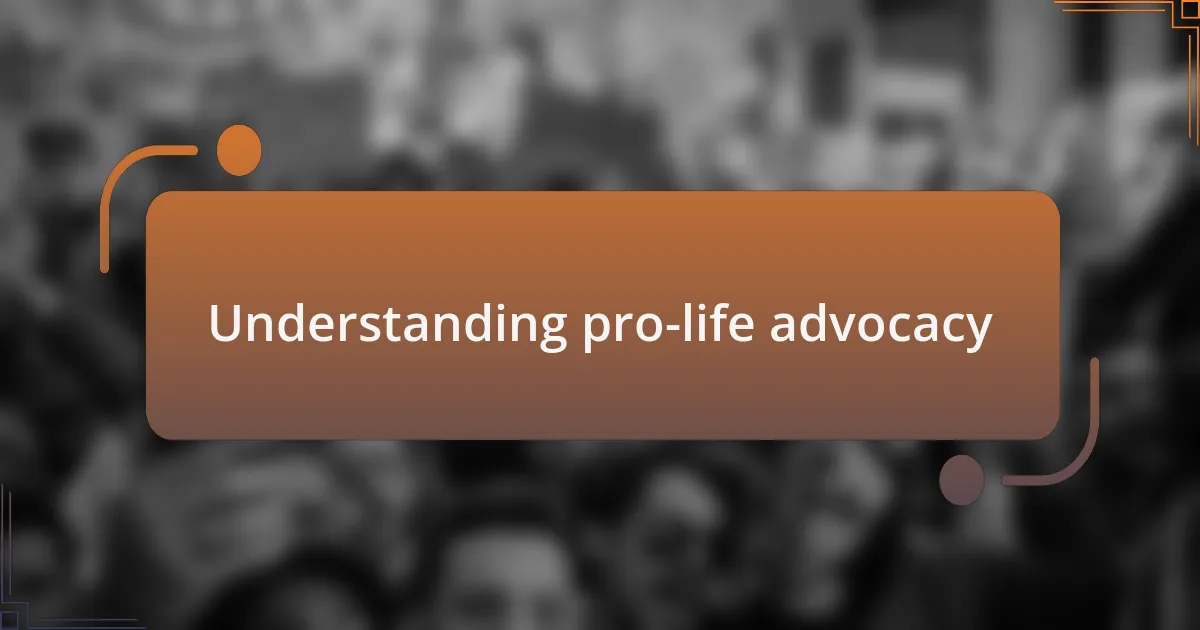
Understanding pro-life advocacy
Pro-life advocacy is rooted in the belief that every human life has inherent value, from conception to natural death. I remember attending a local rally where individuals shared heartfelt stories of challenges and triumphs, reinforcing why this cause is so vital. It struck me how many faces shared a common journey, each story a testament to the power of hope and resilience.
Understanding this movement requires delving into the diverse perspectives that shape it. Have you ever considered how personal experiences can influence one’s views on life? For me, hearing from those who chose life in challenging circumstances opened my eyes to the profound impact of support and community. Each voice adds layers to the conversation, reminding us of our collective responsibility.
Moreover, pro-life advocacy isn’t just about opposing abortion; it encompasses a broader commitment to supporting families and promoting alternatives. I recall volunteering at a crisis pregnancy center, where I witnessed firsthand the transformative power of nurturing care. It made me realize that advocacy means standing with pregnant individuals, ensuring they have the resources and support to thrive, not just survive.
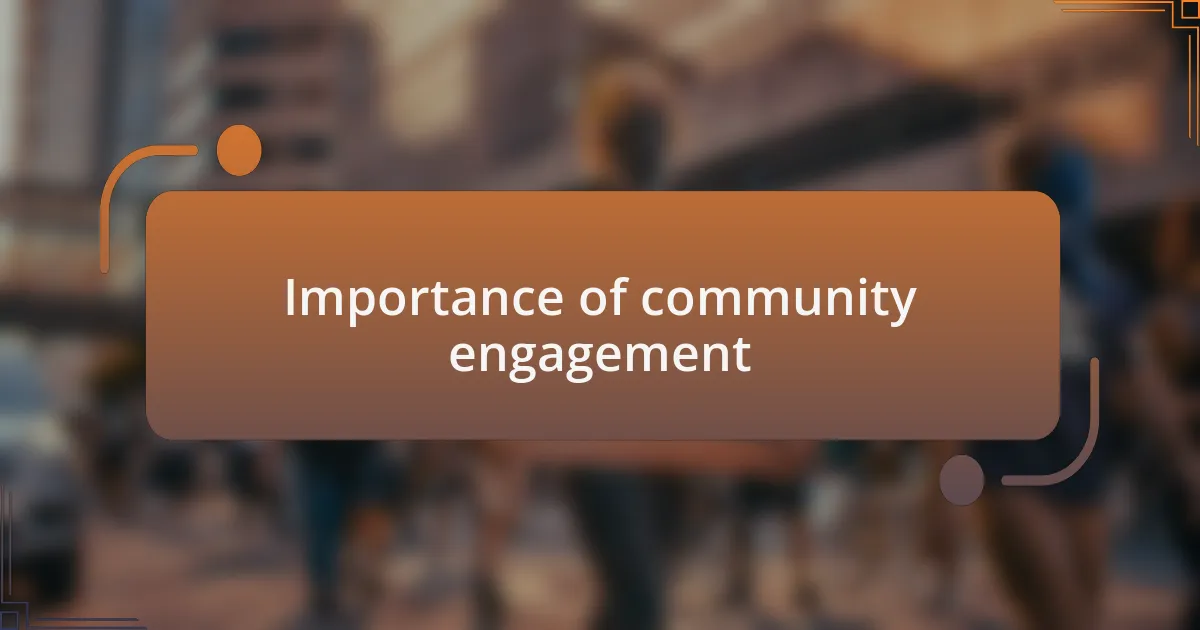
Importance of community engagement
Engaging with the community is essential in pro-life advocacy because it builds a network of support and solidarity. I once organized a community forum where families shared their experiences with unexpected pregnancies. The room was filled with raw emotion; it was clear that when people feel heard and supported, they become empowered to advocate for life together.
Moreover, community engagement fosters understanding and compassion. I vividly recall a time when we hosted a panel discussion that included not just pro-life advocates but also individuals who had different viewpoints. Hearing diverse perspectives opened up meaningful dialogues and helped diffuse tension. Isn’t it incredible how conversation can bridge divides and create a space for healing?
Ultimately, community involvement transforms abstract concepts into lived experiences. I saw this firsthand when our group collaborated with local schools to educate young people about the value of life. Watching students actively participate and share their thoughts was inspiring; it reminded me how vital it is to enrich our communities with love and understanding. What could be more impactful than nurturing the next generation to cherish every life?
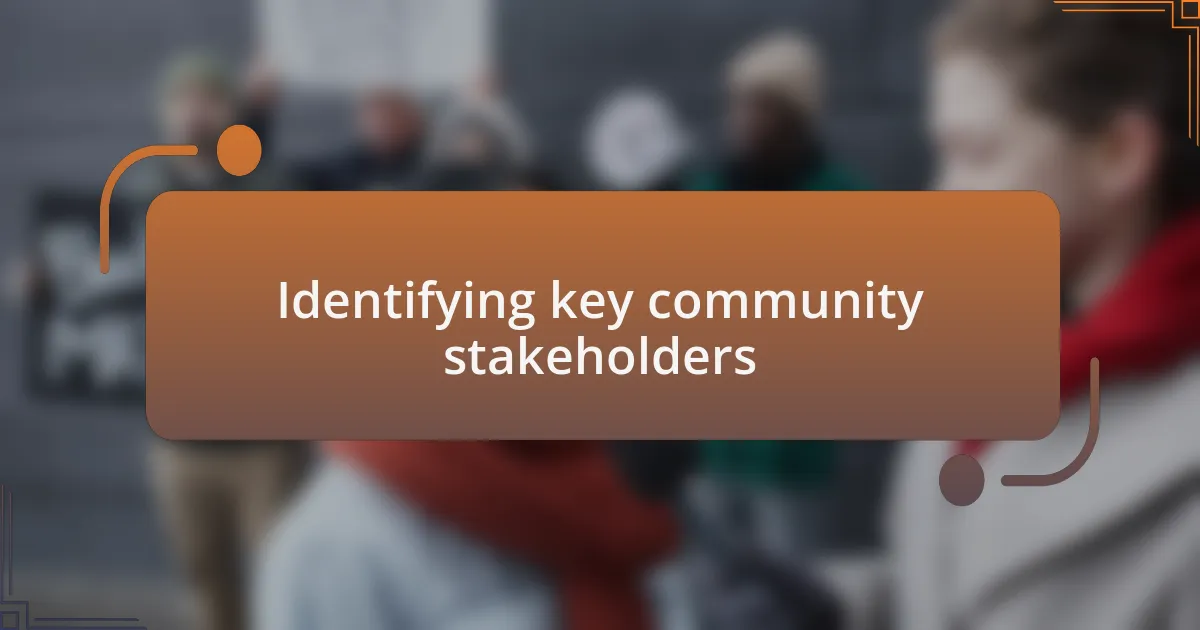
Identifying key community stakeholders
Identifying key community stakeholders is crucial in crafting an effective pro-life advocacy strategy. I remember a time when I reached out to local healthcare providers and faith leaders; these individuals were invaluable in understanding the unique needs of our community. By identifying who holds influence and trust, advocacy efforts can be amplified where it matters most.
As I took the time to meet with these stakeholders, I discovered the power of their networks. One local teacher, for instance, not only shared insights on youth engagement but also introduced us to parents who had powerful stories about navigating difficult choices. This collaboration transformed our approach and underscored the importance of considering various voices when advocating for life.
In my experience, engaging with stakeholders also cultivates a sense of ownership in the mission. I watched a group of local business owners rally around our cause after realizing its impact on community well-being—a reminder that when stakeholders feel personally connected, they’re more likely to lend their support. Isn’t it inspiring how collective efforts can create a ripple effect of change?
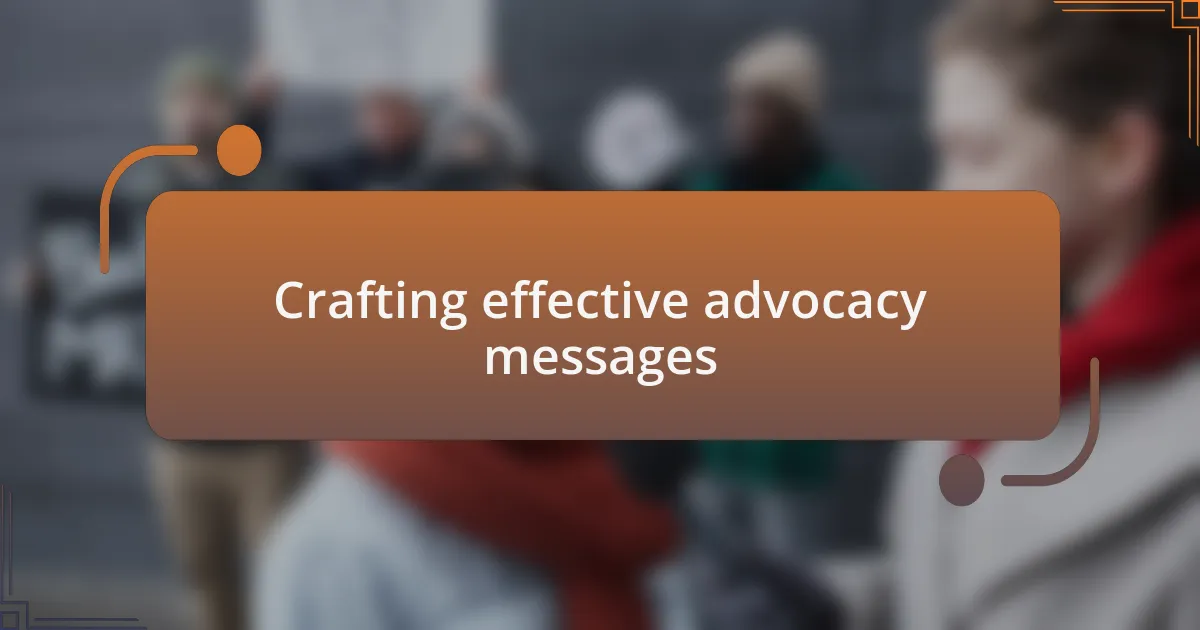
Crafting effective advocacy messages
When crafting effective advocacy messages, it’s essential to tap into the emotional narratives that resonate with people. I recall a moment when I shared a heartfelt story about a woman from our community who faced an unplanned pregnancy. The way her decision to choose life transformed her life and the lives of her family not only captivated our audience but also sparked discussions that led to greater engagement. How can we ignore the power of personal stories in igniting passion for our cause?
Clarity is another vital component. During a recent campaign, I focused on simplifying complex policy issues into digestible messages that anyone could understand. For instance, instead of overwhelming statistics, I opted for scenarios illustrating real-life consequences of policy changes. I was amazed at how this simpler approach invited more conversations and inquiries, proving that clarity encourages curiosity and action. Isn’t it fascinating how a few well-placed words can bridge gaps between policy talk and personal connection?
Furthermore, incorporating calls to action creates a sense of urgency. I learned to frame our messaging not just around the problem but also with straightforward steps for community members to engage. For example, inviting people to share their stories or participate in local events made the advocacy feel like a community effort rather than a solitary battle. Reflecting on this, I realize that empowering others to take action not only strengthens our movement but also fosters a culture of support and shared responsibility. Don’t we all yearn to be a part of something bigger than ourselves?
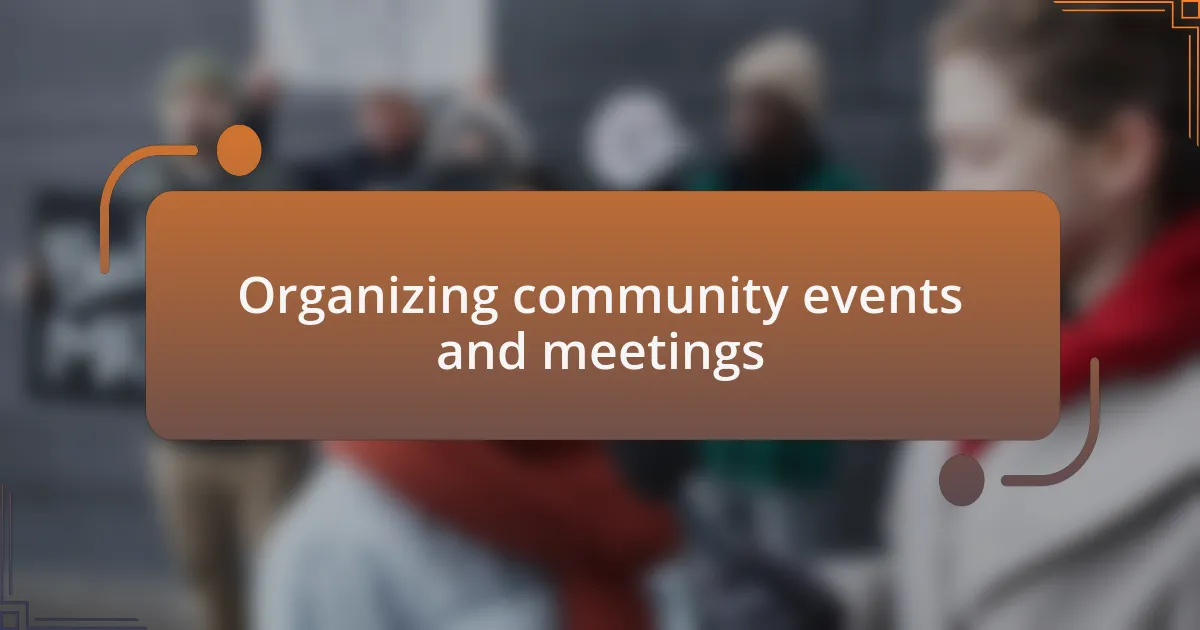
Organizing community events and meetings
Organizing community events and meetings plays a pivotal role in solidifying our advocacy efforts. I remember planning a local gathering where we invited speakers from various backgrounds connected to the pro-life movement. Seeing the diverse faces of our attendees—some curious, some passionate—really underscored the importance of creating spaces where these conversations could thrive. Have you ever felt the electric buzz of shared purpose in a room? Those moments are priceless.
During another event, I decided to create breakout sessions where attendees could share their experiences and thoughts. The connections formed during those small group discussions were incredible. I watched as individuals who entered as strangers began to articulate their hopes and fears about life issues, which not only deepened their engagement but also sparked new ideas for our advocacy initiatives. It’s amazing how people can inspire one another when they feel safe to voice their opinions, isn’t it?
I also discovered the value of follow-up meetings after significant events. These gatherings allowed us to build momentum by collectively reflecting on our progress and strategizing the next steps. For example, after a successful rally, we met to discuss how we could keep the conversation going within our broader community. It was during these sessions that I realized true engagement happens not just in isolated moments but in ongoing dialogues that cultivate a sense of belonging and collective responsibility. Don’t you think that continuous engagement is what truly strengthens our advocacy?
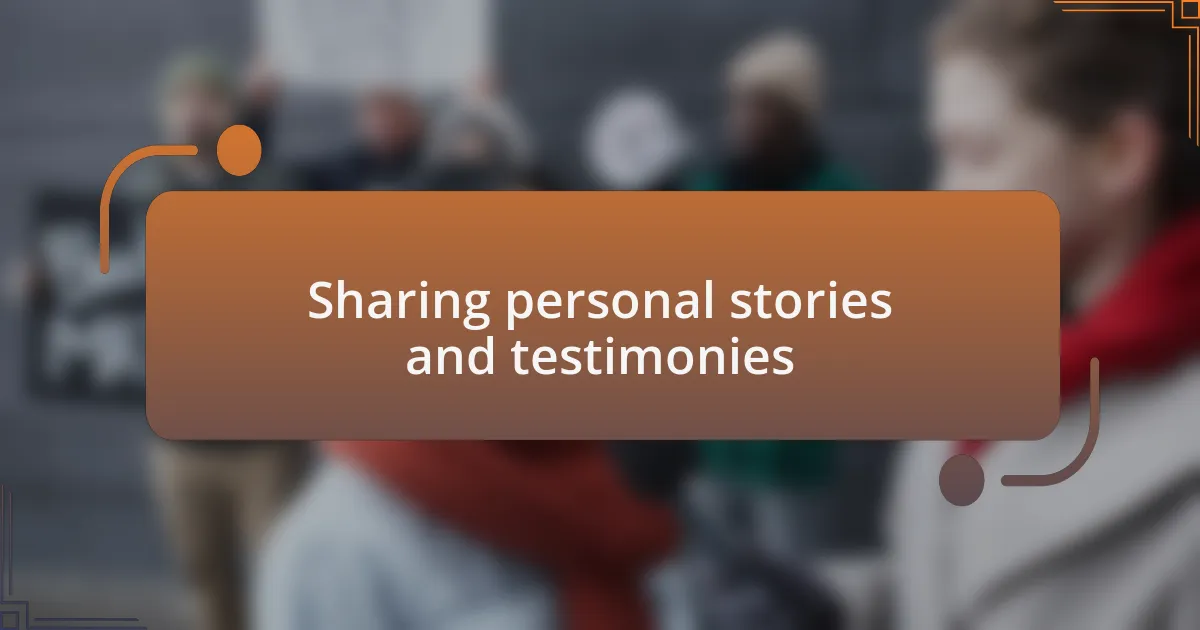
Sharing personal stories and testimonies
Sharing personal stories and testimonies is where the heart of our advocacy truly beats. I remember a powerful moment when a young woman bravely shared her journey of unplanned pregnancy at one of our gatherings. Her love for her child and the challenges she faced resonated deeply with the audience, fostering empathy and support. Have you witnessed the shift in energy when someone opens up about their struggles? It’s as if the room collectively breathes in understanding.
I’ve noticed that when community members share their stories, it not only humanizes the pro-life stance but also creates a deeper connection among us. One man spoke about his experience of being an involved father, highlighting the joy and challenges that accompany parenthood. As he spoke, you could feel the room leaning in—people weren’t just listening; they were reflecting on their own lives and choices. Isn’t it fascinating how vulnerability can trigger personal reflections and ignite change?
Moreover, I’ve found that these testimonies often bridge the gap between differing viewpoints. During a discussion, a woman who had previously leaned towards a pro-choice perspective listened intently to a mother’s account of her decision to carry her baby to term despite immense difficulties. By the end of the conversation, there was a seed of understanding planted, demonstrating how storytelling has the power to challenge perceptions and inspire dialogue. Don’t you think those personal narratives could be the key to fostering genuine conversations in our communities?